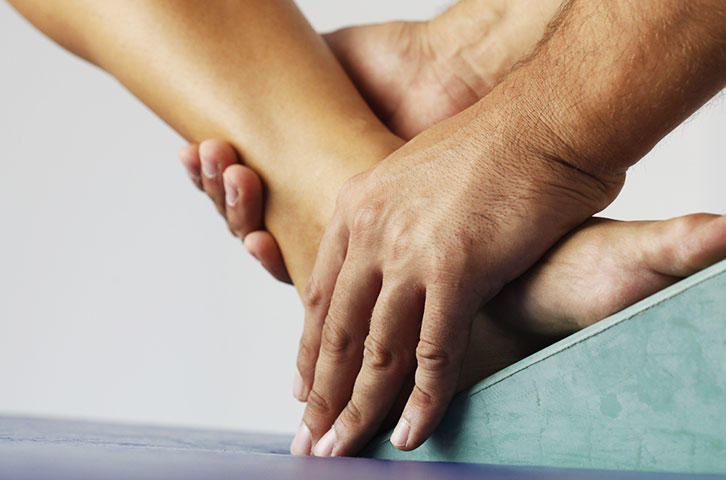Manual Therapy: Definition
The phenomenon of manual therapy is typically defined as a method of affecting damaged tissues in a direct way (i.e., manually) so that their functions could be restored after an injury or trauma had affected them negatively and contributed to a partial loss of the functions mentioned above. The subject matter is adopted as regular practice by chiropractors, osteopaths, massage therapists, physiotherapists, occupational therapists, naturopaths, etc. (Genna, 2012, p. 257). Manual therapy is traditionally classified as a specimen of complementary and alternative medicine (CAM) and is used to treat the disorders and diseases related to the musculoskeletal system.
Examples: Manual Therapy Techniques
Soft Tissue Mobilization
The Soft Tissue Mobilization technique (STM) is aimed at relaxing the muscle tissue that can be described as fibrous and lacking elasticity and typically defined as a myofascial adhesion. The given approach is aimed at fighting a muscle spasm or a certain tension in the muscle tissue. As a rule, the technique is applied to the muscle mass located in the spinal area (see Fig 1). Traditionally, the therapy involves stretching, applying pressure to the target area, etc. Prior to using the technique, a therapist is supposed to identify the damaged tissue with the help of a layer-by-layer assessment (Manual therapy, 2016).

Joint Mobilization
Similarly to the STM approach, the technique involving joint mobilization (JM) is related to a muscle spasm inflicted by a trauma (e.g., a pulled muscle). The specified technique presupposes that the swollen joints should be loosened with the help of a massage technique. The latter includes moving the bone surfaces with an increasing velocity in the manner that the patient cannot perform due to the swelling. Along with the velocity of the movement, the amplitude should also increase gradually (see Fig. 2).

Manual Therapy Practitioners: Analysis
Education
To become a manual therapist, one must attend the corresponding seminars during which one can acquire the necessary skills and knowledge. A range of organizations such as Hands-on Seminars (About us, 2016), the North American Institute of Orthopedic Manual Therapy (NAIOT) (About, 2016), etc., hold training courses that provide an all-embracive overview of the concept of manual therapy, teach various techniques thereof, and shed light on how these approaches work, thus, increasing the quality rates of manual therapy services.
Scope of Practice
Since the area of manual therapy is rooted deeply in the evidence-based approach, its scope of practice can be defined as fluctuating (Manual therapy, 2016). Currently, manual therapy practitioners are permitted to address the issues related to neurological disorders, revive chronic pain in patients, treat asthma, manage the problems related to women’s health, etc. (World Confederation for Physical Therapy, 2016).
Treatment Claims
The medical claims provided by manual therapists to their patients to receive specific drugs are considered valid and, therefore, can be used as long as the therapist in question has a license (Clinical/medical massage, 2016).
Successful Manual Therapy Treatment: Case Study Report
Introduction
In his article, Martínez (2012) addresses the effects of manual therapy on cervical pain in adults. The author makes it quite clear that the subject of the research (cervical pain) is a topical issue that needs to be addressed from the perspective of manual therapy. By incorporating the manual therapy approach based on an evidence-based practice into the study, Martinez builds a compelling argument in favor of the use of manual therapy.
Analysis
Problem statement
The issue of nonspecific cervical pain is comparatively hard to address due to the problems related to the identification of factors causing it. Therefore, the adoption of the traditional healthcare strategies, i.e., the use of medicine, can be viewed as dubious due to the possibility of negative outcomes. The adoption of manual therapy, particularly, the use of the manipulation and mobilization techniques, however, is likely to help the patient recover without subjecting them to the threat of adverse effects.
Decision criteria
According to Martinez (2012), the acquisition of multiple high-quality randomized control trial results could serve as solid criteria for coming to specific conclusions.
Data analysis
The data was gathered with the help of electronic and manual searches across the existing databases. Seeing that the RCT was used as the key tool for processing the information retrieved, it can be assumed that the data analysis tools were rather credible: “In this study, we evaluated meta-analyses and systematic reviews of randomised controlled trials (RCTs) because they represent the best scientific evidence in the hierarchy of evidence based medicine (EBM)” (Martinez, 2012).
Preferred alternative
The outcomes of the study point clearly to the fact that the use of manual therapy, in general, and mobilization, in particular, affects the patients’ wellbeing positively. Combined with exercise, the approach in question can be viewed as advisable.
Recommendations
Martinez’s study is comprehensive and accurate. The research question asked in the introduction as answered accordingly; however, the study may need further improvement. It is suggested that the author should focus solely on the manual therapy use as opposed to the current comparison to the traditional approach. Thus, different manual therapy tools can be compared to identify their flaws and suggest improvements.
Reference List
About. (2016).
About us. (2016). Web.
Clinical/medical massage. (2016). Web.
Genna, C. W. (2012). Supporting sucking skills in breastfeeding infants. Woodhaven, NY: Jones & Bartlett Publishers.
Instrument assisted soft tissue mobilization (IASTM). (2016). Web.
Manual therapy. (2016).
Martínez, J. A. M. (2012). An overview on the efficacy of manual therapy (manipulations and mobilisations) on nonspecific cervical pain: A systematic review in adults. In J. Bettany-Saltikov (ed.), Physical therapy perspectives in the 21st century – Challenges and possibilities (91–106). Shanghai, CHN: InTech.
World Confederation for Physical Therapy. (2016). Scope of practice. Web.